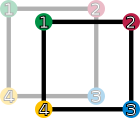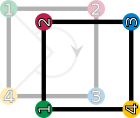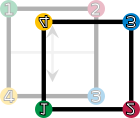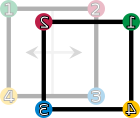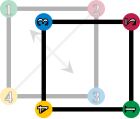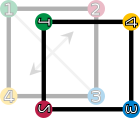Group (mathematics)
In abstract algebra, a group is an algebraic structure formed by a non-empty set endowed with an internal operation that combines any pair of elements to compose a third within the same set, and that satisfies the associative properties, of existence of the neutral element (also called identity), and of existence of inverse elements (sometimes called symmetric).
The appearance of groups in various areas of knowledge (both within and outside of mathematics) makes them a central principle around which contemporary mathematics is shaped and established, with immediate application in other scientific areas.
Definition and motivation of the concept
First example: the additive group of integers
One of the best known groups is the sum of the integers, denotated by Z{displaystyle mathbb {Z} }. The whole of the integers consists of natural numbers, their negatives and zero. It therefore contains all real numbers that have no decimal part. It is commonly described as
- Z={...,− − 3,− − 2,− − 1,0,1,2,3,...!{displaystyle mathbb {Z} ={...,-3,-2,-1,0,1,2,3,...}.
The properties of this arithmetic operation will help to illustrate the concept of a group:
- The sum of two integers is in turn an integer: if none of the numbers have decimal part, their sum does not have it either. This property is called algebraic closure, and it is said that the whole of the integers is closed under the sum.
- You can dispense with parenthesis to indicate the precedence of operations: although the sum is defined for each two numbers, there is no ambiguity in the expression a+b+cbecause the result of the operations (a+b) + c It's the same as that of a + (b+c). Therefore, the sum of integers verifies the associative property.
- There is a special and unique number, the zero, which added to any other does not alter its value: a+0 = aWhatever. a.
- For each integer athe opposite (-a) is in turn whole and such that a + (-a) = 0.
These four properties are also verified for a great variety of operations, not necessarily numerical, which leads to the definition of an abstract concept -that of group- in which all of them are included. This definition, based on axioms, allows the development of an abstract theory -group theory-, whose results are applicable to all groups regardless of their concrete formalization, since the results are derived solely from the algebraic structure common to all of them.
In the case of addition of integers, the order of the addends is not important, since for any a and b, it holds that a +b = b+a. This is the commutative property, which however is not assumed to be true in general for all groups, so in group theory special attention is paid to the order of the operands.
Axiomatic definition
Sean. G{displaystyle G} an unempty set, and {displaystyle circledast } a binary operation defined in G{displaystyle G}. It's said the pair (G, ){displaystyle (G,circledast)} is a group if the following conditions are met (called group axioms(c):
- The binary operation {displaystyle circledast } It's a internal operation, that is, take two elements of the whole G to obtain a third also in G. Consequently, it is an application
:G× × G→ → G{displaystyle quad quad circledast:Gtimes Gto G}. - The operation {displaystyle circledast } check it out. associative property: given three elements of any g,h,k한 한 G{displaystyle g,h,kin G}, it's fulfilled
(g h) k=g (h k){displaystyle quad quad (gcircledast h)circledast k=gcircledast (hcircledast k)} - G{displaystyle G} contains a distinguished element called neutral element or identity, usually noted as e{displaystyle e}with the following property: for any g한 한 G{displaystyle gin G}
e g=g e=g.{displaystyle quad quad ecircledast g=gcircledast e=g. ! - All element g한 한 G{displaystyle gin G} He has a symmetrical element or inverse in the same G{displaystyle G}, denoted by g− − 1{displaystyle g^{-1}with the property that
g g− − 1=g− − 1 g=e.{displaystyle quad quad gcircledast g^{-1}=g^{-1}circledast g=e. !
Sometimes to simplify the speech is said G{displaystyle G} is a group when we wish to indicate that (G, ){displaystyle (G,circledast)} It's a group.
A group G{displaystyle G} is called abelian (or commutative) if the commutative property is also satisfied
- Русский Русский g,h한 한 G:g h=h g,{displaystyle forall g,hin G: gcircledast h=hcircledast g}
which, however, is not an essential requirement: there are non-abelian groups.
Associated algebraic structures
In abstract algebrae, alternative algebraic structures of the type are studied (E, {displaystyle circledast }), being E a non-nulled set {displaystyle circledast } an internal binary operation, which can be total (defined for all pairs of elements) or not. Most of them are defined by group axioms that they verify.
The most basic of all is the magma: a pair (E, {displaystyle circledast }) is a magma if the binary operation {displaystyle circledast } is total, and therefore satisfies the first group axiom. A magma whose operation {displaystyle circledast } be associative is called semi-group. Consequently, a semi-group satisfies the first two group axioms. If you also check the third (neuter absence) then it is a monoid. The above definitions are not exclusive: a group satisfies all axioms, and therefore every group is a magma, a semi-group and a monoid.
Note that in order to talk about inverse elements, the identity element must exist. However, in the absence of a neutral element, the concept of division can be defined: given a and b, b is said to be divisible by a if there are elements x and y, uniquely such that
- a x=b,and a=b{displaystyle acircledast x=bquadquadquad ycircledast a=b}.
In such case the division is defined by the left as x=a b{displaystyle x=asetminus b} and division on the right as and=b/a{displaystyle y=b/a}. A master with division (between any couple of elements) is called quasi-group. If you also have an identity element, it becomes a loop. An associative loop is therefore a group.
In case the operation {displaystyle circledast } not total, the simplest structure is the semi-groupid, which only fulfills the associativity. If you also have an identity, it becomes a small category. Finally, a small category with divisibility is called a groupide. This type of structure is studied in the field of category theory.
Historical review and current situation of research on group theory
The concept of a group arose from the study of algebraic equations in an unknown, beginning with Évariste Galois during the 1830s. After contributions from other fields such as number theory and geometry, the notion of a group became more widespread and became firmly established around 1870.
The definition of group (G, *) using: associativity, the existence of a neutral element, an inverse element and the notion of binary operation, was formulated by F.G. Frobenius, for the first time in 1887, noting that the theorems that he demonstrated depended solely on the proposed axioms and without having to resort to the apparatus of permutation groups, used by his predecessors Cauchy, Jordan and Sylow.
Commutative groups are those that, in addition to verifying the commutative property, are usually called abelian groups in honor of the Danish mathematician Niels Henrik Abel who, in his very important contribution, demonstrated the irresolution of the quintic by means of radicals in 1846 from Ruffini in what is called the Abel-Ruffini theorem and due to the repeated use of commutative groups in his investigations. Later, Évariste Galois proved with his new theories that the irresolvability of the group S 5 would imply the irrefutable demonstration of what Abel discovered about the irresolvability of the quadratic equation through the use of radicals.
Because the first groups studied in history were the multiplicative ones, their nomenclature and notation came to be used extensively in the generalization of axiomatic and abstract definitions in group theory; although it is necessarily recommended to use the notation and nomenclature proper to abstract algebra.
Modern group theory (a very active mathematical discipline) studies groups themselves. In order to explore groups, mathematicians have devised various notions in order to divide groups into smaller, more understandable subsystems, such as subgroups, quotient groups and simple groups. In addition to its abstract properties, group theorists also study the ways in which a group can be expressed in concrete form (its group representations), both from a theoretical point of view and from a computational point of view. An especially rich theory was developed for finite groups and culminated in the classification of finite simple groups completed in 1983. Also, since the mid-1980s, geometric group theory, which studies groups of finite generation as geometric objects, has been become a particularly active area in broad group theory.
The crucial importance of group theory in both physics and mathematics lies in the fact that the isomorphisms of any structure, of any theory, always form a group and that, in the most important cases, the groups are classified: they are known lists that exhaust all there is. The classification of Lie groups, essentially carried out by Élie Cartan, is a highlight of European mathematics, only comparable to the construction of the 5 regular polyhedra carried out by Greek mathematics. Just as the latter is the determination of all possible symmetrical geometric figures, group classification is the determination of all possible symmetries of any structure. Thus, we can know a priori the groups of automorphisms of any geometric theory. Furthermore, according to Felix Klein's Erlangen Program, this group of automorphisms reconstructs the corresponding geometric theory.
Something similar happens in physics, where it has been discovered that the group of symmetries of the Lagrangian of a system determines fundamental properties associated with the elementary particles of said system. The classification of Lie groups provides the list of possible existing groups of infinitesimal symmetries, valid for eventual and future scientific models.
Group theory and the study of symmetries: field of applications
Group theory shares a fundamental kinship with the notion of symmetry. A symmetry group encodes the symmetry characteristics of a geometric object: it consists of the set of transformations that leave the object invariant and the operation of combining two of these transformations.
- Such groups of symmetry and especially the differentiable Lie groups, have an important role in topology and other branches of mathematics such as the matrix groups and operators.
- In physics they are used to understand the fundamental physical laws on which relativity is based, they are also used in very diverse physics fields such as particle physics, field theory, quantum physics and even new fields of current physics such as unifying theories (M theory and string theory) among many other applications.
- In chemistry studies related to the theory of liaison, molecular symmetry, atomic symmetry and even radiactivity.
- In geology and more specifically in crystallography.
Second example: a symmetry group
The symmetries (that is, the rotations and reflections) of a square form a group called dihedral, and it is expressed as D4. A square has eight symmetries. These are:
- The identity operation that leaves everything as it was, is expressed as id.
- 90° square rotations, 180° and 270° to the right, expressed with r1, r2 and r3respectively.
- Reflections on vertical and horizontal axles (fv and fh), or regarding the two diagonals (fd and fc)
Notation and nomenclature in group theory
Axiomatics of groups
The pair (G, {displaystyle circledast }) represents a set, not necessarily numerical, to which we denote G (group) and an internal binary operation « {displaystyle circledast }», which does not have to be an arithmetic operation to use.
- Other capital letters can be used to represent groups that are groups, in general, the use of letters is preferred To even G, except C, being the first option G.
- In the case of subgroups, the first option is H and following, excepting K (bodies), N (natural), R (real), I (identity or irrational), Q (rational) and Z (enteres) or any other that originates lack of expositive clarity.
- The group elements are represented with tiny letters: a, b, c, d, f, g...
- The symmetrical elements with respect to one given, are represented with the same letter marked with a pattern: a! ! ,b! ! ,c! ! ,d! ! ,f! ! ,g! ! ,...{displaystyle {bar {a}},{bar {b}},{bar {c},{bar {d},{bar {f}}},{bar {b}}}, !.
- The neutral element is represented with the letter e.
- To represent internal composition laws, the following symbols are often used:
Δ Δ , , , , , , .{displaystyle odot ;,quad circledcirc ;,quad oplus ;,quad ominus ;,quad circledast ;,quad otimes ;,quad oslash ;.}
Multiplicative notation
This is the most frequent notation in textbooks:
- The operation is called product or multiplication. Depending on the context, it is noted with one of the following symbols (among others):
- ⋅ ⋅ ,∙ ∙ ,↓ ↓ ,⋆ ⋆ ,Δ Δ ,× × , {displaystyle cdot ;,quad bullet ;,quad ast ;,quad star ;,quad odot ;,quad times ;,quad otimes }
- The most common is the use of the sign "by" (⋅ ⋅ {displaystyle cdot }or your elision. The repeat product of an element a himself denotes himself as
- nSometimes{displaystyle quad {,,,,,,,,,,,,,n,,{text{veces}}}}}}
- an=a⋅ ⋅ a⋅ ⋅ a⋅ ⋅ ...⋅ ⋅ a {displaystyle a^{n}=overbrace {acdot acdot acdot acdot a} }.
- Neutral element to be called element oneand denotes by 1 instead of e{displaystyle e}. When there can be confusion between two or more groups, the neuter symbol is denoted with a subscript, as in 1Gto refer specifically to the group G.
- Symmetric Element: In multipliative groups it is called inverse element and his notation is x− − 1{displaystyle x^{-1}. The division of two numbers, symbolized by signs such as ":" or "/", is defined as the product of one number by the reverse of the other. Notations of the type ab{displaystyle {frac {a}{b}}}} or a/b{displaystyle a/b} are usually reserved for numerical groups (generally Abelians) because otherwise it could lead to confusion between a− − 1⋅ ⋅ b{displaystyle a^{-}1cdot b} and b⋅ ⋅ a− − 1{displaystyle bcdot a^{-}1}They can differ. In general, for the reverse the notation is preferable a− − 1{displaystyle a^{-1}Before 1/a{displaystyle 1/a}.
Additive notation
Additive notation is used exclusively for abelian groups:
- As a symbol of the operation the sum is used «+». Repeated sum of an element a himself denotes himself as
- nSometimes{displaystyle quad {,,,,,,,,,,,,,,,,,{text{veces}}}}}
- na=a+a+a+...+a {displaystyle na=overbrace {a+a+a+a} }.
- The neutral element for the addition is noted by 0instead of e{displaystyle e}and is called zero or null element. When there can be confusion between two or more groups, the zero symbol is denoted with a subscript, as in 0Gto refer specifically to zero of the group G.
- The symmetrical of an element x it denotes as -x. In this context it is called the opposite or negative element of x. In rigorous application of additive notation should be written x + (-y), but frequently used x - andwhere the subtraction of two numbers is defined as the sum of the first plus the opposite of the second. In any group, the opposite of -x That's it. x, and therefore you have to -(-x) = x.
In the above it is not assumed that x is positive and that -x is negative because, among other reasons, in some groups in which the additive notation is used there is no intrinsic notion of the sign of the element, as for example in complex numbers or in vectors.
Concepts and main results
Elementary results
From the definition of the group structure, based solely on the four axioms mentioned above, several immediate consequences follow directly:
- The neutral element of the group is unique.
| Demonstration |
Sea G a group that has two identity elements, denotated e1 and e2. Applying the definition, as the first of them is identity:
But also the second is identity, and therefore
Since the product of two elements is unique, it follows that e1 = E2. |
- Each element of a group has a single symmetrical element.
| Demonstration |
Sea x{displaystyle {x} an arbitrary element of a group G. Suppose this element has two inverses, denotated x! ! {displaystyle {bar {x}}} and x~ ~ {displaystyle {tilde {x}}}. Applying the definition of symmetrical element:
Multiplying both sides of equality on the left x~ ~ {displaystyle {tilde {x}}} obtained
But like x~ ~ x=e{displaystyle {tilde {x}{x}=e}simplifying these terms on the left side results
with what both inverses are the same element. |
- Cancellation: given three arbitrary elements a, b and c of a group G:
- ac = bc implies that a = band
- ab = acc implies that b = c.
| Demonstration |
In the first equality, multiplying both members on the right by the reverse c (which exists in G(c):
In the second equality a similar result is obtained by multiplying on the left by the reverse of a. This argument makes use of associative property by changing the evaluation order (ac)c− − 1=a(cc− − 1){displaystyle (ac)c^{-1}=a (cc^{-1}}}. |
- Given two elements whatsoever A{displaystyle A} and B{displaystyle B} of a group Gthe equation Ax=B{displaystyle Ax=B} has solution in G And it's unique.
| Demonstration |
Premultiplicating both sides of the equation by A− − 1{displaystyle A^{-1} obtained
There is therefore a solution x=A− − 1B{displaystyle x=A^{-1}B}. It is also unique, since there is another element and{displaystyle and} such as Aand=B{displaystyle Ay=B} then. Ax=Aand{displaystyle Ax=Ay}. Canceling A{displaystyle A} deduces that x=and{displaystyle x=y}. |
Subgroups
Given a group G, a subset H is said to be a subgroup of G if, considering the restriction of the operation on G to the elements of H, the group axioms are satisfied. In practice this means that it is closed (the product of two of its elements is in the subgroup) and which contains the inverses of all its elements.
Given a subgroup H of group G, define the left cosets of H in G as the sets of the form
- aH={ah h한 한 H!{displaystyle aH={ahmid hin H}}.
Similarly, the right side classes are defined Ha{displaystyle Ha}. The lateral classes are equivalence classes, and therefore determine a partition of G. A subgroup is called normal if your left and right side classes match.
Order of the group and its elements
A group may have infinite elements, such as the additive group of the integers, or on the contrary have a finite number of elements. In a finite group (whose underlying set is finite), the order of the group is defined as the number of its elements. Given an element a of a group, defines the subgroup generated by a as the set of elements obtained by repeated multiplication of a or his reverse. When this subgroup is finite, of order k, it is said that the order a That's it. k. This is the least positive number such that ak=e{displaystyle a^{k}=e}. In another case it is said that a It is of infinite order.
The order of the elements and the order of the subgroups of a finite group divide the order of the group (Lagrange's theorem). This result is a consequence of the fact that the cosets of a subgroup all have the same cardinal, equal to that of the subgroup.
Group Homomorphisms
Group Actions
Examples of some notable groups
Typically, the sum of numbers and other types of mathematical objects can be described by an abelian group:
- Additive groups of whole, rational, real and complex numbers:
- (Z,+) (Q,+) (R,+) (C,+){displaystyle (mathbb {Z}+)subset (mathbb {Q}+)subset (mathbb {R}+)subset (mathbb {C}+)}}.
- Additive groups of dimension-free vectors n with real components (Rn,+){displaystyle (mathbb {R} ^{n},+)} or complexes (Cn,+){displaystyle (mathbb {C} ^{n},+)}.
- Additive groups of order matrices m x n with tickets on a ring A{displaystyle {mathcal {A}}} arbitrary: (Am× × n,+){displaystyle ({mathcal {A}}^{mtimes n},+}.
- The additive group of successions of real numbers, with the sum term to term: (RN,+){displaystyle (mathbb {R} ^{mathbb {N} },+}.
- Remain classes module n with the módular sum, Z/nZ{displaystyle mathbb {Z} /nmathbb {Z} }, form a finite group of order n. For example, the group Z/12Z{displaystyle mathbb {Z} /12mathbb {Z} } represents the hours in the dial of a watch, where 12+1=1 (12 is the identity of the group).
Similarly, the product of certain mathematical entities gives them a group structure, not always abelian. However, elements that lack a multiplicative inverse (such as the number zero) must be excluded:
- Multimulative groups of rational, real and complex numbers (excluding zero, which is denoted with the superscript deployment deployment × × {displaystyle square ^{times }}(c):
- (Q× × ,⋅ ⋅ ) (R× × ,⋅ ⋅ ) (C× × ,⋅ ⋅ ){displaystyle (mathbb {Q} ^{times },cdot)subset (mathbb {R} ^{times },cdot)subset (mathbb {C} ^{times },cdot)}.
- In the extero numbers, the multipliative group of integers that have inverse (which is generally called in any unit ring, its group of units):
- U(Z)=({− − 1,1!,⋅ ⋅ ){displaystyle U(mathbb {Z})=({-1,1},cdot)}.
- The square matrices of order n with real and determinant coefficients other than zero (and therefore invertible) form a group with the matrix product, which is not commutative when n.. It is called a linear general group and denotes GL(R,n){displaystyle GL(mathbb {R}n)} or GLn(R){displaystyle {GL}_{n}(mathbb {R})}.
- Successions of positive real numbers with end-to-end product ((R+)N,⋅ ⋅ ){displaystyle (mathbb {R} ^{+})^{mathbb {N},cdot}}}.
- The multiplier group of complex module numbers 1: ({z한 한 C 日本語z日本語=1!,⋅ ⋅ ){displaystyle ({zin mathbb {C} mid Șz1},cdot}.
- In the module debris classes n with modular multiplication, its multiplier group is defined as the group of coprim classes with n. For example, in Z/6Z{displaystyle mathbb {Z} /6mathbb {Z} }, the multipliative group consists of the kinds of remains {1,5!{displaystyle {1,5}}. Yeah. n is cousin then the multipliative group contains all elements except identity, so its order is n-1.
Other examples of groups (typically non-commutative) are obtained by considering groups of transformations of a space X (bijective functions of X itself), where the operation is the composition of applications and the neutral element is the identity function:
- The symmetrical group: the group that contains all the transformations of a space X.
- The group of the movements of the space or group of isometrics of the euclid space.
- The group of the similarities of the plane or the group of the affinities of a straight (the applications of the form x ax+b{displaystyle xmapsto ax+b} with a other than zero).
- The group of Galileo, formed by the transformations of space-time into classical mechanics. In the theory of relativity, the equivalent is the group of Lorentz, which is in turn subgroup of the group of Poincaré, the latter of interest in quantum field theory.
Types of groups
Depending on the generator sets of a group, the finitely generated groups can be distinguished, which are those with a finite generator set. A counterexample is the group of real numbers under the sum (R,+){displaystyle (mathbb {R}+)}which is not generated by any of its finite subsets. Every finite group is finitely generated, but the reciprocal is not true, as in the case of free groups or free abelian groups. The smaller finite group is the trivial group, which contains only one element, then necessarily the identity. All groups contain the trivial group as a subgroup.
The most elementary finitely generated groups are the cyclic groups, in which one element is sufficient to generate the group. An example is the additive group of integers (Z,+){displaystyle (mathbb {Z}+)}, which is generated by 1 (or alternatively by the -1which shows that there is not necessarily a single generator element. Except isomorphism, every infinite cyclic group is isomorphic to it, while finite cyclics are isomorphic to Z/nZ{displaystyle mathbb {Z} /nmathbb {Z} }for a certain natural number n equal to the order of the group.
The groups in which the commutative property is verified are called abelian (or commutative) groups. In them, the subset of finite elements (called torsion elements) form a subgroup: the subgroup of torsion. When no other element of identity is of torsion, it is said to be a group free torsion. The structure theorem of finitely generated abelian groups establishes that any of these groups is the direct product of a torsion-free group -product of several copies of Z{displaystyle mathbb {Z} }- (unless finite) and its torsion subgroup (product of finite or trivial cyclic groups).
A topological group is a topological space endowed in addition to a group structure, compatible with topology (that is, both the operation of the group and the inversion are continuous functions). If it also has a differentiable manifold structure, then it is called a Lie group. Other topological groups are the discrete groups, which are those endowed with the discrete topology (in which each element is isolated). Examples of the latter are the Kleinian, Fuchsian or triangular groups, among others.
When a group lacks proper normal subgroups it is called a simple group. Sometimes (e.g. in finite groups) it is possible to decompose a group into simple groups, called factor groups, by means of a composition series. When it exists, this series is unique, but two groups with the same series are not necessarily isomorphic. If all the factors are abelian groups, the group is said to be solvable.
Fonts
References
Contenido relacionado
Co-NP-complete
Riemann zeta function
Alain Connes



















